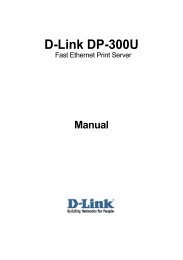Unified Access Point (AP) Administrator's Guide
Unified Access Point (AP) Administrator's Guide
Unified Access Point (AP) Administrator's Guide
You also want an ePaper? Increase the reach of your titles
YUMPU automatically turns print PDFs into web optimized ePapers that Google loves.
D-Link <strong>Unified</strong> <strong>Access</strong> <strong>Point</strong> Administrator’s <strong>Guide</strong><br />
Features and Benefits<br />
This section lists the DWL-3500<strong>AP</strong> and DWL-8500<strong>AP</strong> features and benefits, which are in the<br />
following categories:<br />
IEEE Standards Support<br />
Wireless Features<br />
Security Features<br />
Networking<br />
Maintainability<br />
<strong>Access</strong> <strong>Point</strong> Hardware<br />
IEEE Standards Support<br />
The DWL-3500<strong>AP</strong> comes configured as a single-band access point with one radio and is<br />
capable of broadcasting in the following modes:<br />
IEEE 802.11b mode<br />
IEEE 802.11g mode<br />
Dynamic Turbo 2.4 GHz<br />
The DWL-8500<strong>AP</strong> comes configured as a dual-band access point with two radios and is<br />
capable of broadcasting in the following modes:<br />
IEEE 802.11b mode<br />
IEEE 802.11g mode<br />
IEEE 802.11a mode<br />
Dynamic Turbo 5 GHz<br />
Dynamic Turbo 2.4 GHz<br />
The DWL-3500<strong>AP</strong> and DWL-8500<strong>AP</strong> access points provide bandwidth of up to 54 Mbps for<br />
IEEE 802.11a or IEEE 802.11g, 108 Mbps for IEEE 802.11a Turbo, and 11 Mbps for IEEE<br />
802.11b.<br />
Wireless Features<br />
The following list describes some of the DWL-3500<strong>AP</strong> and DWL-8500<strong>AP</strong> wireless features:<br />
Auto channel selection at startup<br />
Transmit power adjustment<br />
Quality of Service (QoS) for enhanced throughput and better performance of timesensitive<br />
wireless traffic like Video, Audio, Voice over IP (VoIP) and streaming media<br />
Wi-Fi Multimedia (WMM) compliance for QoS<br />
Load Balancing<br />
Built-in support for multiple SSIDs (network names) and multiple BSSIDs (basic service<br />
set IDs) on the same access point<br />
Channel management for automatic coordination of radio channel assignments to reduce<br />
<strong>AP</strong>-to-<strong>AP</strong> interference on the network and maximize Wi-Fi bandwidth<br />
Neighboring access point detection (also known as “rogue” <strong>AP</strong> detection)<br />
Support for IEEE 802.11d Regulatory Domain selection (country codes for global operation)<br />
Support for IEEE 802.11h, incorporating TPC and DFS<br />
Support for Super AG technology, which can increase WLAN speed and throughput<br />
16 © 2001-2008 D-Link Corporation. All Rights Reserved.
















